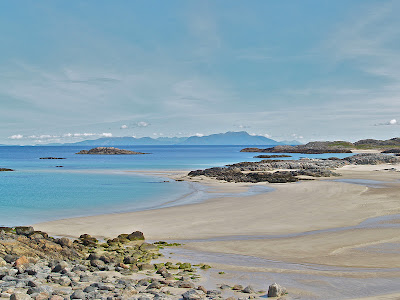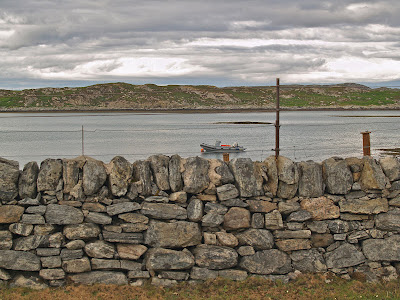The visit to Coll prompted a search of websites to obtain information and what stood out was the glorious honesty of the visitcoll website which is designed and maintained by the local community.'Coll has, for example, no visitor points; no tourist information; no interpretation panels to ruin the landscape; no theme parks; next to no signposts; no mobile phone coverage (except a few spots, and then only sometimes); no public transport of any sort; no McDonald's, TESCO or Apple Store etc. (and long may it remain that way); no policeman; no traffic lights; no street lights; no parking meters; the worst road surfaces you are likely to find in the UK; the most expensive diesel and petrol in the UK; and often - nowhere to go whilst it rains.' Yep, Coll was all these things and as such a wonderful escape from the avalanche of guidance and urgings of corporate Britain.
Compare this to the vacuous blurb found on the visitscotland website, the Scottish Government-funded website that is supposed to promote tourism. It does not appear on the first 20 pages of a Google search for Coll and then is found yoked together with Tiree, it's a very different neighbouring isle.
'The fish-shaped rocky island of Coll lies less than 7 miles off the coast of Mull. The CalMac ferry drops off at Coll's only real village, Arinagour, whose whitewashed cottages line the western shore of Loch Eatharna, a popular safe anchorage for boats. The village also hosts most of the island's services and facilities. Coll offers a range of accommodation options, but bed spaces are inevitably limited, so advance booking is always recommended.
If you were looking for evidence of small communities providing a reliable witness and the 'top-down' voice of a centralised quango's empty rhetoric you couldn't find a better comparison. The brutal truth of the visitcoll site has an authentic voice; VisitScotland is full of marketing clichés that generate instant boredom but no trust.
In a Borders town last week, the dais for the torch bearers' handover with the Provost and a group of young people was abandoned because local shop signs were visible behind it. Without the platform, the assembled crowd were unable to watch an Olympic hero, Allan Wells, the Moscow 100m gold medallist, hand over the torch. The feedback from several sources suggests that the marketing juggernauts of Coca Cola etc. aided by overzealous Metropolitan Police Officers were riding roughshod over carefully planned local activities. Across the country, local heroes who have served the community or overcome adversity were sacrificed as torch-bearers to create opportunities for wealthy wannabes who paid to carry the torch. What a sad nation we are becoming.
Hampden Park, which is to host some group football games, is unable to sell tickets - this is not an anti-London Olympics stance, it is so that the crowd will only be able to drink Coca-Cola instead of Irn Bru, Scotland's indigenous fizzy drink. An argument is still raging about what drink and food can be consumed and the size of the exclusion zone around Hampden.
This sort of top-down corporate marketing is anathema to an increasingly savvy public and will hopefully resurrect the sale of more local food and drink around the country. It does raise the question of whether companies realise the adverse effects of their totalitarian marketing. 'Boycott Global, Buy Local' would be a good response to the big brand exclusion zones that Lord Coe and co. are trying to impose on us.
Compare this to the vacuous blurb found on the visitscotland website, the Scottish Government-funded website that is supposed to promote tourism. It does not appear on the first 20 pages of a Google search for Coll and then is found yoked together with Tiree, it's a very different neighbouring isle.
'The fish-shaped rocky island of Coll lies less than 7 miles off the coast of Mull. The CalMac ferry drops off at Coll's only real village, Arinagour, whose whitewashed cottages line the western shore of Loch Eatharna, a popular safe anchorage for boats. The village also hosts most of the island's services and facilities. Coll offers a range of accommodation options, but bed spaces are inevitably limited, so advance booking is always recommended.
If you were looking for evidence of small communities providing a reliable witness and the 'top-down' voice of a centralised quango's empty rhetoric you couldn't find a better comparison. The brutal truth of the visitcoll site has an authentic voice; VisitScotland is full of marketing clichés that generate instant boredom but no trust.
 |
| Olympic Sponsors |
The Olympic torch has also provided some fine examples of the absurdity of modern marketing. Not only are a large proportion of the torch bearers nominated by the sponsoring companies but local businesses are being excluded from getting any coverage on the torch route. It has become a rolling billboard for the sponsors and an exclusion zone for any advertising that conflicts with sponsors - Coca-Cola, Samsung and the Bank of Scotland among them.
In a Borders town last week, the dais for the torch bearers' handover with the Provost and a group of young people was abandoned because local shop signs were visible behind it. Without the platform, the assembled crowd were unable to watch an Olympic hero, Allan Wells, the Moscow 100m gold medallist, hand over the torch. The feedback from several sources suggests that the marketing juggernauts of Coca Cola etc. aided by overzealous Metropolitan Police Officers were riding roughshod over carefully planned local activities. Across the country, local heroes who have served the community or overcome adversity were sacrificed as torch-bearers to create opportunities for wealthy wannabes who paid to carry the torch. What a sad nation we are becoming.
 |
| Alan Wells in Selkirk |
 |
| But not at Hampden for the Olympics |
This sort of top-down corporate marketing is anathema to an increasingly savvy public and will hopefully resurrect the sale of more local food and drink around the country. It does raise the question of whether companies realise the adverse effects of their totalitarian marketing. 'Boycott Global, Buy Local' would be a good response to the big brand exclusion zones that Lord Coe and co. are trying to impose on us.




















































